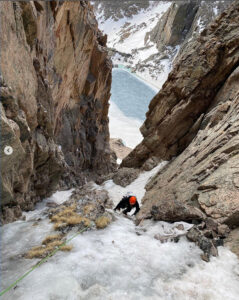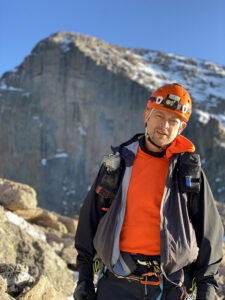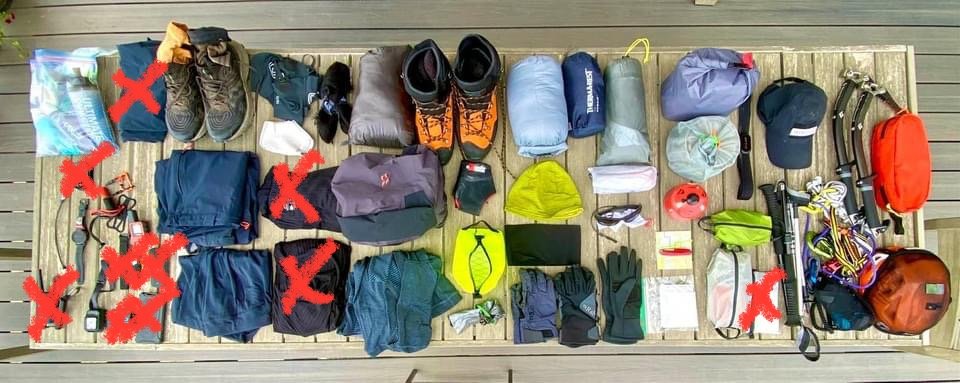A Climbing Passion Reignited after Two Decades
Brian Carlock
Sometimes when you get slapped around, you have to keep stepping forward.
I repeated this mantra to myself as I stumbled over the snowbound talus encircling Chasm View Lake, in Rocky Mountain National Park (RMNP), Colorado, en route—slowly—back to my bivy higher in the cirque. I was bonking, hard, due to a combination of the attitude and improper provisioning. I’d brought only Gu energy gels and a single liter of water for a guided outing on Kiener’s Route (5.4; easy snow) up the east face of Longs Peak: 3.18 miles in technical alpine terrain, 2,677 feet of gain to the summit (14,291 feet), 2,598 feet of elevation loss back into the cirque, and what would end up being 12 hours on the go. And now I was paying for my error. I shuffled along, stopping here and there to catch my breath. Eventually we made it back to camp.
It was May 2022, and I’d come out from my home at sea level in Sarasota, Florida, for two days of guided climbing in RMNP with Jason Antin, who’d been my Uphill Athlete (UA) coach for the past year-and-change. Jason had been both mentor and confidante as I got back into a sport I’d always deeply loved—but had taken a long hiatus from, one that had left me overweight and out of shape. When I started back into climbing in early 2021, working with UA on my conditioning, my first thought was: “I have no idea where this is going and if I can achieve it, but let me give it a shot anyway.”
Now, at age 56 and in probably the best form of my life, I’m glad I did.
Jason Antin
It has been a phenomenal journey working with Brian, both as his coach and on the climbs we did together. When he came to me through UA, I conducted a standard new-athlete interview to see where Brian was at physically and mentally, using the standard UA pillars of Capacity Building: Aerobic, Anaerobic, Strength, and Technical. I also added my own fifth pillar: Mental Capacity building. I’m a strong believer in “benchmark” outings to see where we stand before taking on the primary goal. Brian was not new to alpinism, and knew what it was like to be out in the mountains moving in technical terrain, but it had been awhile (like, two-plus decades). In some ways it’s easier to coach an athlete back to and beyond where they have previously been, so I knew Brian would have a head start.
In fact, his previous experience in the mountains would likely give Brian a significant advantage in achieving his goals—as long as he could adapt to a body, mind, and place in life that were different from his last journey into the alpine.
Brian

I grew up going into the outdoors thanks to a tradition of outdoorsmanship handed down from my father and grandfather. My father was in the military, stationed in Alaska, where I was born and spent most of my formative years.
Our lifestyle was “full-on outdoors”: cross-country skiing, snowshoeing, ice fishing, you name it. In high school in Kansas, I became an Eagle Scout. One of our Scoutmasters was into rappelling, and would take us rapping into quarries to practice our ropework. I immediately loved climbing and would go whenever I could, even in flatland Kansas. This meant clambering on rock walls along the railroad tracks and on buildings (the police were called more than once to run us kids out of there). I continued climbing in college in Idaho and Utah; when my career took me to Manhattan, I became a Gunkie and East Coast ice aficionado. I was “all in” on ice climbing for eight or nine years, and became proficient enough to feel confident leading the famous Black Dike (5.6 WI 4–5 M3) at Franconia Notch every season.
Then my career took over, and I drifted away from the sport. There wasn’t any single reason—just a slow parting of ways. Soon twenty years had gone by without climbing.
In early 2021, I was zoning out on social media and randomly saw some beautifully filmed drone footage of climbers on the Black Dike. Oh my god; I remember that, I thought. I commented to my best friend and former climbing partner that “I’d love to go back.” And he was, like, “Why can’t you?” And I was, like, “You’re right—why can’t I?” Just because I lived in Florida didn’t mean I couldn’t be a climber again, and so I researched my options. I’d always felt a deep connection with climbing. For me, the thing was being out in nature and the focus—that whole concentration of, It’s the next stick, the next kick. That perfect elixir of outdoorsmanship plus Zen plus athleticism had been missing from my life for far too long.
Jason
Brian’s fond memories of the Black Dike from his climbing career version 1.0 resonated strongly with me. I recalled my own ascent of the Black Dike as well. It had been an incredibly formative experience, and I still recall my own outing like it was yesterday. I know what it takes to climb the Black Dike. That route, through our own individual journeys, helped me understand the experience that Brian had had and what he was after as he returned to climbing.

Brian
I’d be lying if I said getting back into shape was easy, especially that first month. As I went about figuring out how to become a climber again, I flashed back to reading Mark Twight’s Extreme Alpinism back in the day. I knew before I could climb again that I had to get back into shape. I poked around online for what to do next. I’d heard of Steve House’s books and coaching company, Uphill Athlete, and so I did a preliminary chat with Steve. I’d soon enrolled with UA, and was off and running with Jason Antin as my coach after a couple of months.
To be honest, the first month of training was brutal and boring as hell—none of it had anything to do with climbing. But I needed to get back on the program with aerobic fitness and overall strength. Living in Florida, I’d kitted out my garage as a home gym, so at least I had that. I had a foldout squat rack, and soon added an incline treadmill and a climbing wall on one side of the garage for dry-tooling—with special holds for picking and cramponing. I put up a bunch of images to inspire me: the Aguille Verte, the Grand Teton, some dramatic alpine climbing shots. Staring at those pictures and imagining where I would be on the route at that moment got me through hard sessions on a number of occasions.
Those early months were emotionally difficult, smacking me in the face to let me know how out of shape I’d become. What got me through was listening to Scott’s podcasts about aerobic threshold, and how you can improve your AeT with structured, consistent training. I was very far down the hill from where I wanted to be, but I kept the faith. The other tough part was injury—I was dealing with bunions, tennis elbow, and golf elbow. At the time, it felt very crushing: I’m putting all this work in, and the age of my body is defying my efforts.
Then I began to see results. Every two or three weeks would mark a new turning point, because that thing that I’d started to do as part of the program two weeks earlier that initially sucked had become easy now. I’m thinking in particular of the videos in Neil Maclean Martin’s Chamonix Mountain Fit At-Home Strength Program. And jogging—at first, I struggled to keep my heart rate down while out for a run, but that improved too. I remember thinking, This is working and it’s possible; this is just the first year, so let me keep going.

Jason
The foundation for many of my Uphill Athletes—in particular those pursuing mountaineering and alpinism—is to make sure they have a sound base of Aerobic Capacity. In other words, I aim to raise their aerobic threshold (AeT). A strong aerobic base complements the movement and tempo of most mountaineering objectives. The stronger the AeT of my athletes, the greater bandwidth they will have to tack on additional components of moving well in the mountains. I sympathized with Brian as he reflected on the first few weeks/months of training. This type of base-building, especially in Florida, takes discipline and desire. It’s all about the long game, and the early stages of building AeT can indeed seem slow and arduous. Because Brian put in the necessary work early on to lay the foundation, he allowed himself to later focus on the “fun stuff” like Muscular Endurance workouts and Climbing movement and conditioning. All of which paid off big time during our time in Rocky Mountain National Park.
Brian
Other than bonking at the end of our first climbing day, my trip to RMNP came off without a hitch. I felt muscularly solid and tuned up on Kiener’s, the weather was perfect during both climbing days, and because it was early season we barely saw any other climbers. On our second day, we climbed Martha’s Couloir (5.5 WI2+ M2–3) on Mount Lady Washington on the north side of Chasm Lake, and that went smoothly too. The trip marked my first time at altitude since I’d quit climbing around the turn of the millennium. It felt incredible to be high in the mountains again.

In fact, my only real issue was the altitude. I felt reasonably strong on the climbing itself, but my crux was breathing. I never felt altitude sickness or like I was going to pass out—having a solid aerobic base helped with all that. But I’d have to pause here and there to catch my breath. Noticing this, Jason suggested I slow my pace, such that I could move consistently and not have to stop so often to recover. In the end, this was a better strategy—you can cover more ground if you just keep moving, even at a slightly reduced pace. Another big takeaway from the trip was that I need to continue building my aerobic base: It’s the major thing that could hold me back on future expeditions.
When I think about my training with Uphill Athlete, I think of two things: One, I didn’t think I’d ever get to this point again. But sticking with the program and gutting through the hard parts works. Now that I’ve got enough of a start, I can see taking on more aggressive goals. And two) The support from UA has been invaluable. Jason has talked me through more than a few of the “freakouts” I faced because of injury or other difficulties. He’s always been there for me, like, “Hey, do you want to chat?”, reminding me that being an uphill athlete is a long-term thing—not just one workout or a few weeks of training, then, boom, back to being sedentary! Looking back on the past year, I can now understand that ebb and flow a lot better.
I’ve learned that being a climber again has got to be more than “I’m going to get ready for a trip, then I’m going to be done.” It has to become a way of life.

